Letters from Lodi
An insightful and objective look at viticulture and winemaking from the Lodi
Appellation and the growers and vintners behind these crafts. Told from the
perspective of multi-award winning wine journalist, Randy Caparoso.
Mike McCay and Harney Lane’s Kyle Lerner share their prognosis of 2018 Lodi Zinfandel
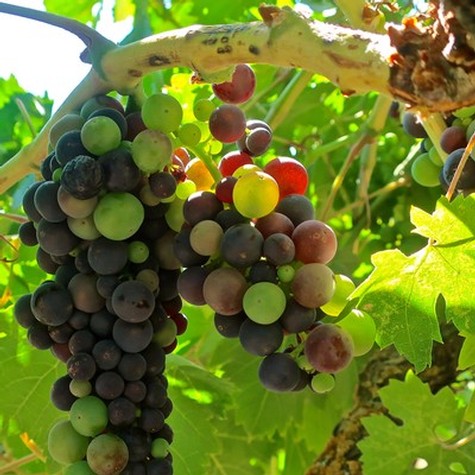
Riot of vivid colors in Zinfandel just beginning 2018 veraison in Harney Lane Winery's Scottsdale Vineyard
How are Lodi’s vaunted old vine Zinfandel vineyards shaping up so far, as of the third week of July 2018?
As warm as the weather this past month has seemed, so far 2018 has not been an especially “warm” vintage in the overall scheme of things. In fact, according to Harney Lane Winery & Vineyards owner/grower Kyle Lerner, “We are tracking as a cooler than average this year.”
Normally – or at least during the past seven years – at this time of year Lodi’s old vine Zinfandels are well into a stage called veraison: from the French word (véraison) for “change of color of grape berries.” Grapes visibly change their hues from a monochromatic green to a blaze of bright colors, from purplish blues to black-ish reds.
But it’s not just the transitioning of colors that growers and winemakers see in the vineyards. To them it also means grapes are reaching a mid-point of seasonal maturation. It is the time of year when berries cease accumulating green mass and start to build up sugars and flavors towards a final sprint towards an optimal, well, deliciousness – when they are ready to be picked and turned into wine.
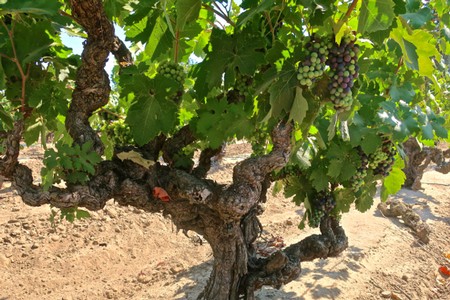
Own-rooted, ancient vine Zinfandel in Scottsdale Vineyard, planted in the early 1900s
Harney Lane Winery’s Scottsdale and Lizzy James Vineyards
Last week, Lerner talked a little about the progress of his two best vineyards, called Scottsdale and Lizzy James. Both vineyards are planted on their own roots in the early 1900s, and both producing distinctive wines bottled under vineyard designated labels by Harney Lane Winery.
Lerner tells us:
Scottsdale is a little 2.5-acre vineyard next to the railroad tracks on Scottsdale Rd., just west of Hwy. 99 (not far from Mohr-Fry Ranches on the south side of town). We have been farming it for fifteen years, and have owned it the past five years.
Right now the Zinfandel vines are showing beautiful balance. I love the cluster development – there’s a little shot berry (i.e. millerandage, resulting from uneven fruit set during the spring), which gives the berries a little space to fill out, which will help avoid any problems with mold or mildew that might pop up later.
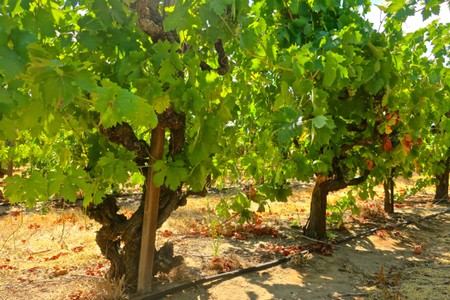
In Lizzy James Vineyard, inter-planting of ancient (planted 1904), old (50-60-year-olds) and younger (20-30-year) Zinfandel
As with all of our vineyards, I can’t say that the balance in the vines is completely natural, since we put in a lot of work to get them that way. It takes a lot of time and effort to attend to each individual vine, but we have the guys in our crew – some of them who have worked for us for over 20 years – who know the vineyards intimately.
I’m talking about guys who know each vine individually, and who really enjoy coming back to them several times a year to prune, thin shoots, pull leaves, drop fruit, and do everything each individual plant needs to produce the absolutely best wine.
Farming an old vine, head trained Zinfandel vineyard is not homogenous work like, say, the Primitivo (i.e. a clonal variant of Zinfandel) we have planted next to the winery, where the entire block is planted to the exact same clone on the exact same trellis. Old vine Zinfandel plants are just the opposite.
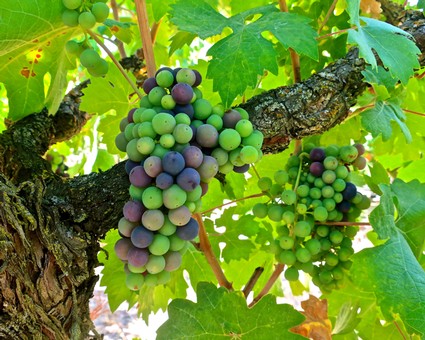
In Lizzy James Vineyard, variable colors of Zinfandel in different stages of veraison
In a vineyard like Lizzy James, for instance, you have some vines as old as 114 years that are on their last legs, putting out just 2 or 3 clusters; and right next to them are younger vines putting out five times more fruit, but balanced by a more vigorous canopy. Each and every vine in a Lizzy James is unique. Each requires a slightly different approach to get them in balance.
So far we’re very pleased with where the old vine Zinfandels are at right now. We’re seeing veraison, but there are still some vines out there with only a berry of two showing color. But days are getting shorter, and if the nights get down to our more typical summer temperature, in the upper 50ºs, this will probably trigger a physiological change – telling the vines to go ahead and finish up the veraison process and begin the final ripening phase. We’ll see what happens over the next few weeks!
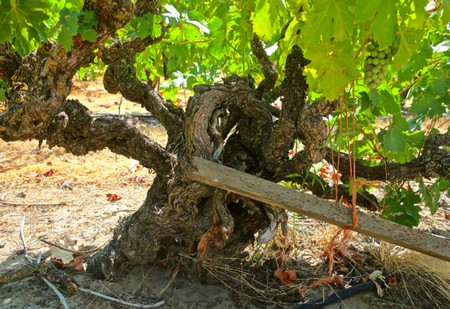
In Lizzy James Vineyard, gnarled ancient Zinfandel still toiling away after 114 years
McCay Cellars’ Old Vine Growths
Over the past ten years, McCay Cellars owner/grower/winemaker Mike McCay has forged a reputation as a brand specializing in as many as five, six, sometimes seven different old vine Zinfandel bottlings each year.
Mr. McCay, of course, is not the only vintner in Lodi doing this. But he is also known for a minimalist, or “hands off,” style of winemaking that puts a strong emphasis on making each single-vineyard Zinfandel taste as different as possible from each other – as opposed to a style of Zinfandel in which a brand or "house" style is clearly discerned in every wine, no matter what vineyard the wine comes from.
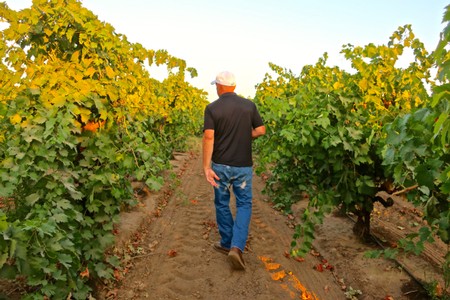
McCay Cellars' Mike McCay walking among 6-ft. tall Zinfandel plants in TruLux Vineyard on Lodi's west side
McCay also sources from old vine Zinfandel vineyards on both sides of Lodi’s Mokelumne River Viticultural Area: the unofficial line demarcating the “east” and “west” sides of Lodi usually considered to be California Hwy. 99, running north-south through the City of Lodi. Old-timers typically talk about east-side and west-side plantings as being byproducts of a slightly deeper, sandier loam on the east side of town, and slightly more organic material found in the sandy loams typifying the west side.
These distinctions usually (not always!) result in rounder, lusher fruit styles of Zinfandels coming from the west side, and slightly sharper, more fragrant styles of Zinfandels coming from the east side. These subtle differences also effect vine growth, as well as resulting cluster and berry sizes, throughout each year and over the long term; "long term," in Lodi, meaning a period of time as long as over 100 years (Lodi’s oldest Zinfandel planting is Jessie’s Grove’s Royal Tee Vineyard, planted in 1889).
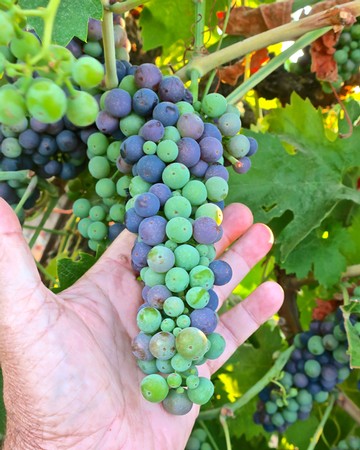
"Perfect" cluster architecture (elongated, loose, variable size berries) of Zinfandel clusters in TruLux Vineyard during 2018 veraison
TruLux Vineyard
This past Saturday (July 21, 2018) we got up at the crack of dawn to catch up with Mr. McCay as he made the rounds through his vineyards on both sides of town. During our walk through TruLux Vineyard – a west-side vineyard consisting of old vines planted on St. George rootstock during the early 1930s, with inter-planted vines dating back to the mid-1970s – Mr. McCay shared some of his observations of the 2018 vintage as of the third week of July:
Right now the weather is perfect for Zinfandel – our days are up in the low to mid-90ºs, and nights are getting down to about 60º. Zinfandel loves these wide, daily temperature fluctuations.
Usually veraison starts in early July, right around July 4. The vines are obviously taking their time this year. We are clearly a week and a half, two weeks behind in comparison to our most recent vintages. This is due to a late winter and spring, when we experienced slightly cooler weather and a little moisture. So the vines woke up a little slower.
I would say that out of the 20 or so clusters on each of these old vines, only about 10 of them have started veraison. A good 8 or 10 of the clusters are still a solid green.
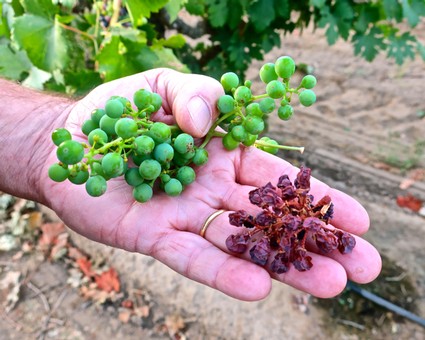
In TruLux Vineyard, dropped fruit from two previous passes through vineyard
You can see here in TruLux that the vines are just beginning to go into veraison. I’m also seeing uniformly longer clusters and slightly smaller berry sizes that what you usually see at this stage. There are a lot of jacks (hard, beady, unformed berries which will later on drop out at the winery crusher), indicative of shot berry, which is normal for Zinfandel, and very normal for this vineyard, which is why TruLux is always been one of our best Zinfandels each year.
This bodes for better than average quality. I really don’t know what it is, but since 2010 in Lodi, the “great” years, for me at least, have been happening in the even years – 2010, 2012, 2014... there really is no rhyme or reason for this. It is what it is.
This year Keith (Watts, owner/grower of TruLux) and I have been working a little harder on shoot thinning and leaf pulling. We want to open up the canopies a little to let more air in, and get a little sunlight on the bunches, which pushes ripening and reduces chances of mold, mildew or rot. As it is, these are unusually tall, 6-ft. high vines with spurs at different heights, which naturally opens up the canopies, so we don’t need to do a lot.
In the 24 years I have been working with this vineyard, I have never seen TruLux looking better. The key to it is balance of canopy to cluster count, and in 2018 the balance is perfect – absolutely kick-butt.
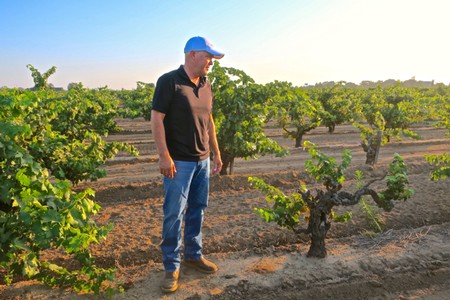
Mike McCay in Bonnotto Vineyard; west side Lodi Zinfandel head trained in a traditional, short, goblet style
Bonnotto Vineyard
At our second stop – Bonnotto Vineyard, located in the heart of Mokelumne River-Lodi’s west-side, right across DeVries Rd. from Spenker Winery – Mr. McCay continued his conversation on old vine plantings in 2018:
I have only been producing Zinfandel from Bonnotto since 2014, although I had been an admirer of the vineyard for years and years before I got the opportunity to work with it. This vineyard is the opposite of TruLux – much shorter, smaller vines, trained in the traditional goblet style, with spurs trained from the trunk in more of an umbrella fashion.
This vineyard was originally planted in the 1930s by Ernie Spenker (a cousin of Joseph Spenker, who founded what is known as Jessie’s Grove today), and has been owned and farmed by the Bonnotto family probably since ‘50s or ‘60s.
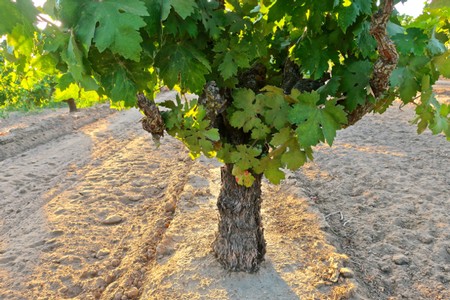
Old school Zinfandel in Bonnotto Vineyard producing barely a handful of clusters in 2018
Bonnotto Vineyard is a perfect example of what a lot of people don’t know about Lodi – that each vineyard is its own character, producing a unique wine. Veraison is barely starting to kick in at Bonnotto, and even the cluster sizes seem smaller than usual. Unlike TruLux, which is probably going to give us a bigger than average crop in 2018, Bonnotto’s bunch count is way down.
It’s almost like this vineyard has decided to take the year off; which goes to show, no matter what you do many old vine vineyards just decide to go their own way.
Lot 13 Vineyard
Lot 13 Vineyard is Mr. McCay’s estate owned vineyard: own-rooted, head-trained Zinfandel planted in 1916 on the east side of Mokelumne River-Lodi, just north of the little community of Victor.
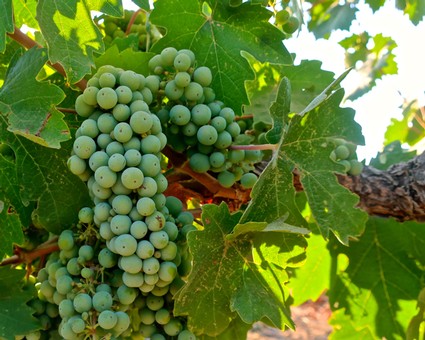
Zinfandel in east-side Lodi's Lot 13 Vineyard; in green, pre-veraison state in third week of July 2018
It is also one of McCay Cellars’ most distinctive wines; producing a delicate, finely etched style of Zinfandel with a distinctive peppery/clove-like spice and floral red cherry perfume. You can smell a Lot 13 Zinfandel from across the room – year after year after year. According to Mr. McCay, during his July 21 rounds:
Lot 13 is one of the more unusual old vine vineyards in Lodi in that over 90% of the vines are the original plantings from 1916. In most older plantings, the percentage of oldest vines is much lower; many less than 50%. Even the vines that look younger in Lot 13, because of their smaller trunks, really aren’t young – they’re just recent re-growths of the original vines which popped up after the original trunks have fallen over or rotted away. Some of the vines in Lot 13 have split totally in half, so it looks like two vines are growing up from one set of roots. If anything, the vines in Lot 13 are resilient – too stubborn to die.
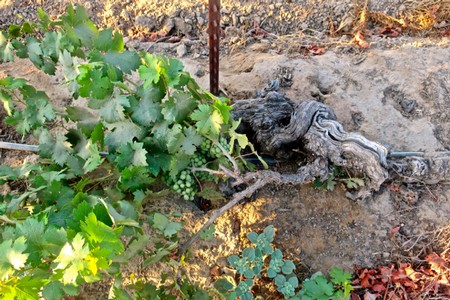
Prostrate 103-year-old vine in Lot 13 Vineyard; fallen, but still growing leaves and fruit
This morning, the first thing you see in Lot 13, after looking at vineyards on the west side, is that the east-side Lodi vineyards are definitely behind the west side. Yet traditionally, Lot 13, as well as Rous Vineyard just a mile away, are usually the first vineyards we pick each year. Not this year. Whether or not this is because of soil factors – the east side vineyards being deeper and higher in sand content – is anybody’s guess, but I’m guessing that it’s the combination of soil differences and circumstances of the weather that’s making this year different from previous years.
(Our note: Tegan Passalacqua, who owns and farms Kirschenmann Vineyard just across the dirt road from Lot 13 Vineyard, tells us that so far in 2018 the stronger, older vines seem to be focusing more on photosynthesizing; possibly as a result of being thrown off by 12 inches of rain earlier in the year).
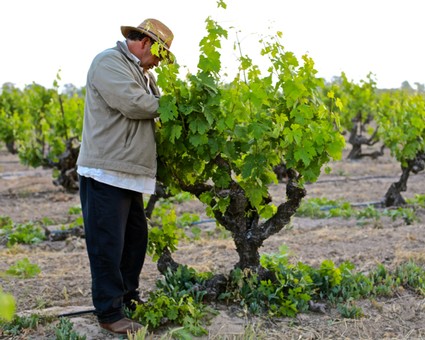
Aggressive shoot thinning to reduce crop and canopy this past May 2018 in Lot 13 Vineyard
If I were to walk through this vineyard last year and see what I see this year, I would say that the date is probably July 1, or even June 20, rather July 21st. While the west side vineyards are maybe two weeks behind normal, it’s more like three weeks here. On most of these vines, there is zero veraison action – the clusters are still tiny and green.
Lot 13 is also looking more like a 3-ton-per-acre vineyard this year, which is a little below average. But this is mostly by design. Because this vineyard is one of the most vigorous old vine vineyards I know, we did very aggressive shoot thinning in May to get the vines in better balance. I’m glad we did. Otherwise, we would have been looking at 5 tons or more, which would have been too much. From experience we know that this vineyard produces its best quality at between 3 to 4 tons per acre.
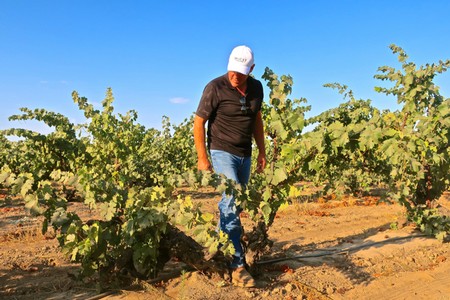
Mike McCay with his boot between a completely split Zinfandel trunk in Lot 13 Vineyard
You’ll also notice another peculiarity about Lot 13 – the clusters typically have few, if any, jacks (i.e. shot berries) – berry sizes tend to be uniform, although clusters are very small compared to my other vineyards. Another perfect example of what makes each old vine planting in Lodi special. Lot 13 has its own identity, producing a style of Zinfandel unlike any other. That’s why we do single-vineyard bottlings.
Last year we did our first picking of this vineyard on August 18. This year we’re probably looking at closer to mid-September. Which is okay, because all it means is more hang-time, and probably one of the better Lot 13s coming down the pipe in 2018!
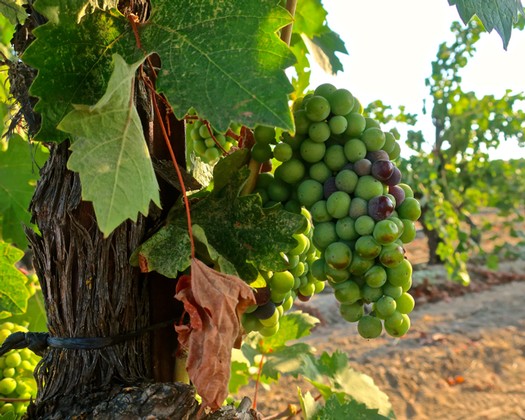
Zinfandel just beginning veraison in McCay Cellars' Lot 13 Vineyard